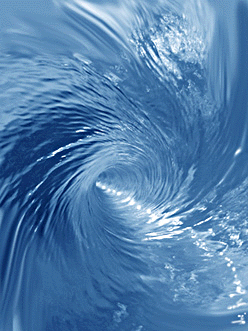...Best of Sicily presents... Best of Sicily Magazine. ... Dedicated to Sicilian art, culture, history, people, places and all things Sicilian. |
by Ignazio Lo Verde | ||
Magazine Index Best of Sicily Arts & Culture Fashion Food & Wine History & Society About Us Travel Faqs Contact Map of Sicily |
Charybdis then took the form of a large underwater mouth that swallows a great quantity of water three times each day, and then releases it into the sea, thus creating whirlpools. The physical phenomenon is not without a basis in fact, though the small whirlpools now seen in the straits are far smaller than those said to have attacked the bands of Odysseus (Ulysses) and Jason (the Argonauts). In avoiding Scylla one might fall prey to Charybdis and vice versa, so the phrase "between Scylla and Charybdis" came to mean that in avoiding one danger a person might fall prey to another. As Scylla dwelled near a rock, the expression "between the rock and the whirlpool" was still popular in the early twentieth century, especially among Englishmen who had the benefit of a solid "public school" education with an emphasis on classics. Crowned by the ruins of a fortress built by the powerful Ruffo family (Queen Paola of Belgium is a Ruffo di Calabria), the Rock of Scylla actually exists and can be identified on the Calabrian coast. The same cannot be said of the domain of the mythological Charybdis, who lived someplace along Sicily's Peloritan-Ionian coast. It has been suggested that Cape Skilla in Greece, rather than the Strait of Messina, may have been the actual inspiration for the ancient myth, but the whirlpools of Messina are no figment of the imagination, and the story's association with Sicily has been known since antiquity. On the other side of the strait things were just as complicated for Scylla as they were for young Charybdis. Something on the order of an ancient soap opera, one might say. Scylla had been a beautiful nymph who had the misfortune of arousing a goddess' envy. Circe, best-known for having turned Odysseus' crew into pigs, transformed her into a six-headed monster when Glaucus, whom the goddess also desired, declared his love for Scylla.
About the Author: Ignazio Lo Verde lectures on Greek classics and other subjects. | |
Top of Page |
 Some myths just won't die. In Greek mythology Charybdis (Kharybdis)
was best known as a sea monster living near the Sicilian side of the Strait
of Messina, said to be the daughter of Poseidon and Gaia, who took the form
of a large whirlpool (water vortex). On the other side of the strait, nearer
Calabria, was the equally menacing Scylla. Just as
Some myths just won't die. In Greek mythology Charybdis (Kharybdis)
was best known as a sea monster living near the Sicilian side of the Strait
of Messina, said to be the daughter of Poseidon and Gaia, who took the form
of a large whirlpool (water vortex). On the other side of the strait, nearer
Calabria, was the equally menacing Scylla. Just as